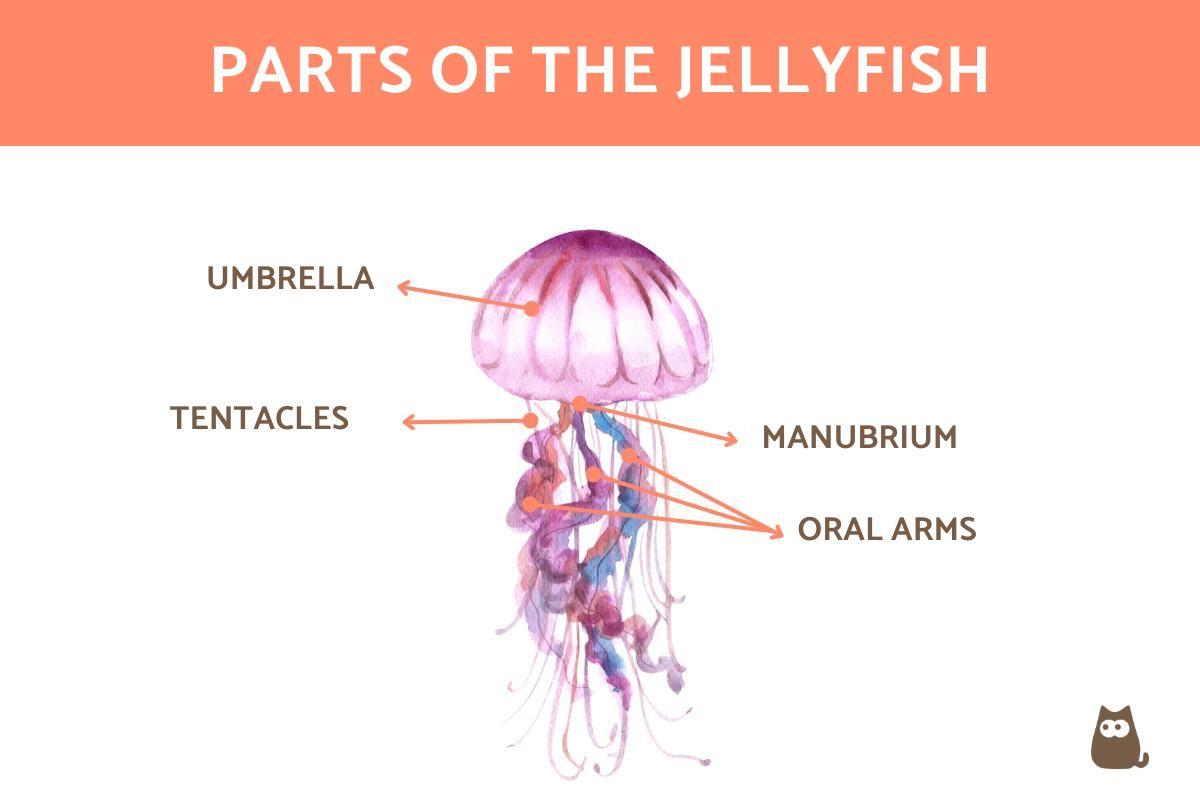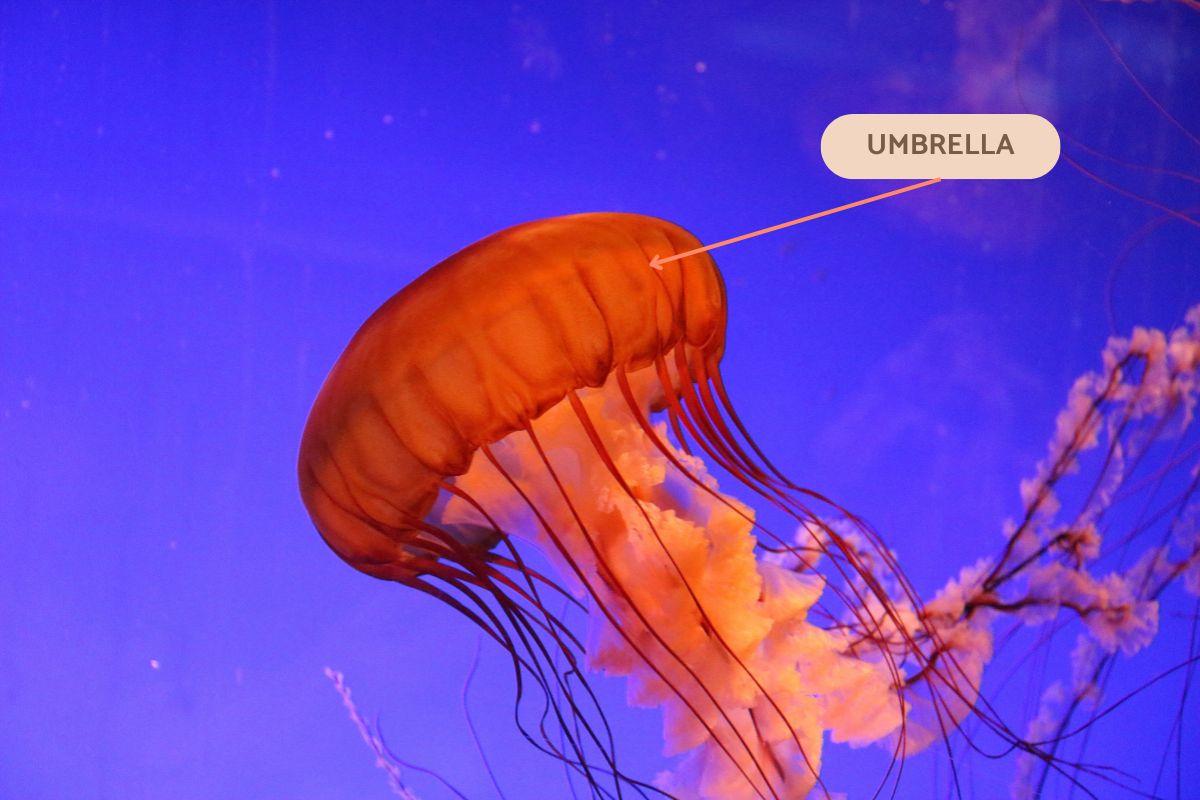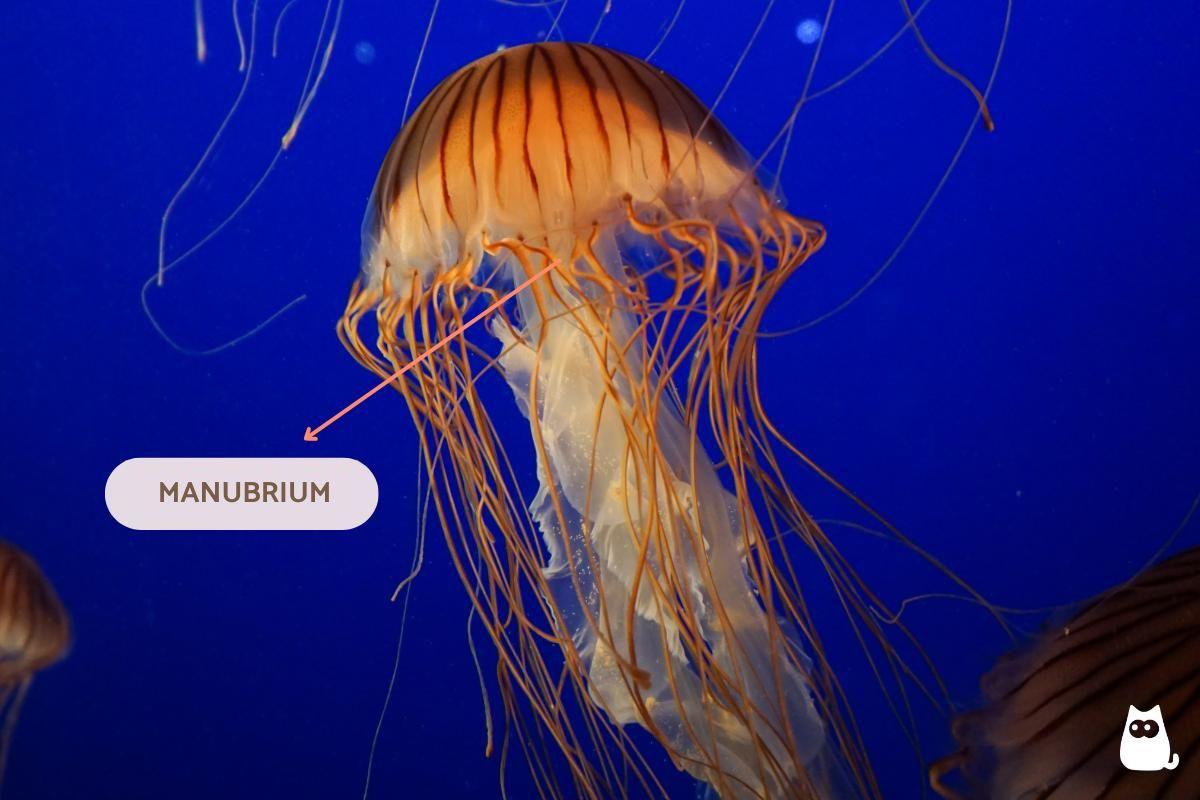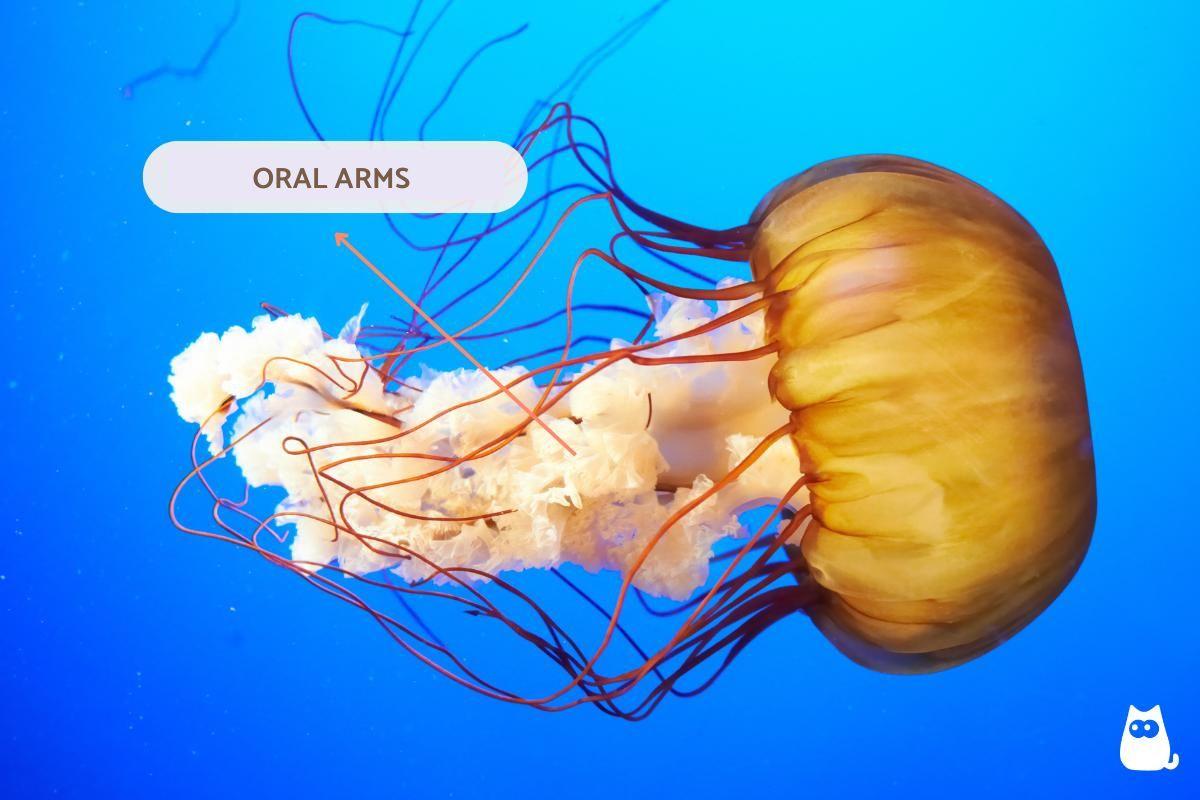What Are the Parts of Jellyfish?


Jellyfish, sometimes called sea jellies, are fascinating gelatinous animals that drift through the oceans. With their translucent bodies and pulsating bells, they might seem like simple creatures. But beneath their seemingly delicate exterior lies a fascinating array of specialized parts that allow them to thrive in the vast ocean depths.
In this AnimalWised article, we'll dive into the different parts of a jellyfish's body, exploring their functions and how these unique structures help them thrive in the ocean.
Umbrella
The umbrella, also known as the bell, is the central and most visible structure of a jellyfish, with its shape varying from hemispherical to flattened depending on the species. The umbrella is crucial for locomotion and other vital functions of the jellyfish.
The umbrella consists of several layers:
- Epidermis: the outermost layer composed of epithelial cells. It protects the jellyfish from the marine environment and contains sensory and receptor cells that detect environmental stimuli such as light and pressure.
- Mesoglea: the intermediate gelatinous layer that makes up most of the umbrella's volume. Primarily composed of water (up to 95%), it also contains collagen fibers and cells. The mesoglea provides structural support, maintains the shape of the umbrella, and acts as a flotation aid, helping the jellyfish maintain its position in the water column. It also serves as a shock absorber, protecting internal structures.
- Gastrodermis: the inner layer lining the gastrovascular cavity (or gastric cavity) of the jellyfish. It is responsible for digestion and nutrient distribution, as the cells of the gastrodermis secrete digestive enzymes that break down captured food.
Functions of the umbrella
The umbrella performs several vital functions:
- Locomotion: through a propulsion mechanism, the umbrella contracts and relaxes rhythmically in a movement known as pulsation. During contraction, water is expelled from the subumbrella cavity (beneath the umbrella, between the dermis and mesoglea), creating a propulsion force that pushes the jellyfish forward. This method is energy-efficient, allowing the jellyfish to move with minimal energy expenditure.
- Attracts prey: the shape and movement of the umbrella generate water currents that draw plankton and small prey towards the jellyfish. These currents direct prey towards the tentacles and mouth, facilitating capture and ingestion.
- Provides structural support and physical integrity: the mesoglea provides structural support and elasticity, allowing the umbrella to maintain its shape and recover after each contraction. It also acts as a shock absorber, protecting the delicate internal structures of the jellyfish, including the digestive system and gonads.
- Orientation: the epidermis contains sensory cells and statocysts (balance organs) that help the jellyfish orient itself in the water and respond to environmental changes, such as the presence of light or currents.
To understand these fascinating creatures even better, explore what fuels them by learning about their feeding habits in another article on our website.

Rhopalia
The rhopalia, or rhopalium, are specialized sensory structures present in some jellyfish, particularly in species belonging to the class Scyphozoa (common jellyfish) and Cubozoa (box jellyfish).
These structures are located at the margins of the umbrella and play a crucial role in sensory perception and regulating the behavior of the jellyfish.
Each rhopalium contains a combination of sensory organs that allows the jellyfish to interact effectively with its environment. Among these organs are statocysts, ocelli, and other chemical and mechanical sensors. Let's explore these components:
- Statocysts are structures that detect gravity and help the jellyfish orient itself spatially. They act as a balance system, informing the jellyfish about its position in the water column, which is essential for maintaining proper navigation and vertical orientation.
- Ocelli are photosensitive structures that function as rudimentary eyes. Although they do not form complex images, ocelli can detect the intensity and direction of light. This allows the jellyfish to move toward areas with favorable lighting conditions or away from intense light that could be harmful. This ability to detect light is particularly important for jellyfish that make daily vertical migrations, moving to the surface to feed at night and descending to greater depths during the day to avoid predators.
- Chemical and mechanical sensors are "all-purpose sensors" pick up on changes in the water around the jellyfish. They allow the jellyfish to respond to the presence of prey, predators, and environmental changes, adjusting its behavior accordingly.
Functions of the Rhopalia
The combination of these sensory organs in the rhopalia allows the jellyfish to have an integrated perception of its environment. This perception is essential for their survival, as it influences their ability to find food, avoid predators, and reproduce. The sensory information collected by the rhopalia is processed and coordinated through the jellyfish's diffuse nervous system, allowing it to execute appropriate behavioral responses. This integrated sensory perception is crucial for detecting changes in the environment and making necessary adjustments to behavior. For instance, detecting light changes or chemical signals in the water helps the jellyfish locate prey and identify potential threats.
In certain species, such as the box jellyfish (Cubozoa), the rhopalia are especially complex and well-developed, reflecting their need for precise navigation in their three-dimensional environment. These jellyfish have eyes with more sophisticated lenses that allow them to form more detailed images, making it easier to actively hunt prey and avoid obstacles. The most venomous box jellyfish species, and one of the most infamous, is Chironex fleckeri, also known as the Australian box jellyfish or sea wasp.

Manubrium
The manubrium is a key muscular structure of the jellyfish's body that plays several vital roles.
The manubrium's shape and size vary depending on the jellyfish species. Some boast a short and stout manubrium, while others have a long and slender one. This variation reflects adaptations to different feeding strategies and lifestyles.
nside the manubrium lies the gastrovascular cavity, essentially the jellyfish's stomach. Food enters through the mouth, located at the lower tip of the manubrium. Here, digestion takes place, breaking down food particles to provide energy for the jellyfish.
The manubrium isn't just a digestive center. It also houses muscles that connect to the umbrella. By contracting and relaxing these muscles, the jellyfish pulsates its bell, generating the powerful jets of water that propel it through the water.
Functions of the Manubrium
The manubrium performs several vital functions for the jellyfish:
- Capturing prey: jellyfish use their tentacles to capture prey, which are then directed toward the manubrium. The tentacles are equipped with cnidocytes that immobilize the prey. The oral arms of the manubrium transport the prey to the mouth for ingestion. The mouth opens to allow the prey to enter the gastrovascular cavity, where digestion begins.
- Digestion: the cells of the gastrovascular cavity secrete digestive enzymes that break down the food into nutrients. These digested nutrients are absorbed through the walls of the manubrium and distributed to other parts of the jellyfish's body via the radial canal system.
- Reproduction:in some jellyfish species, the manubrium plays a role in releasing gametes during sexual reproduction. Gonads located near the manubrium facilitate the release of eggs and sperm into the water for external fertilization.
- Locomotion: although the main function of the manubrium is not locomotion, its shape and position can influence the dynamics of the water around the jellyfish. This helps direct the currents generated by the contractions of the umbrella, aiding in the jellyfish's movement and feeding.
This article explored the fascinating parts of a jellyfish, but did you know there's a dazzling array of jellyfish varieties out there? Discover the incredible diversity of jellyfish with another article on our site.

Oral arms
The oral arms are elongated, flexible structures that extend from the manubrium around the mouth of the jellyfish.
The structure of oral arms varies significantly between different species of jellyfish, reflecting adaptations to their specific habitats and feeding methods. In some species, the oral arms are highly branched, increasing the surface area available to capture prey. In other species, the arms may be covered with cilia (small hair-like projections) that help move food toward the mouth. Some oral arms have a layer of mucus that traps small food particles, making it easier for the jellyfish to capture and consume prey. The length and thickness of the oral arms can vary greatly, with some species having long and thin arms, while others have short and stocky ones.
For humans, the oral arms of some jellyfish species can be dangerous due to their painful stings.
Functions of oral arms
The two main functions of the oral arms are:
- Once prey is immobilized by the tentacles, the oral arms manipulate and move the prey toward the jellyfish's mouth. The arms wrap around the prey, bringing it closer to the manubrium, where it is directed into the mouth and transported to the gastrovascular cavity for digestion.
- The oral arms act as a defense mechanism against predators. Their ability to sting and immobilize threats helps protect the jellyfish from being eaten.
It is worth noting that the oral arms allow jellyfish to capture a wide variety of prey, from small planktonic organisms to small fish, depending on the size of the jellyfish. In this sense, by consuming large amounts of zooplankton, jellyfish play a significant role in regulating planktonic populations in marine ecosystems.

Tentacles
Tentacles are among the most recognizable parts of jellyfish anatomy, alongside the umbrella. These long, thin structures extend from the edge of the umbrella and are critical to the survival of these marine organisms.
The number, length, and arrangement of tentacles vary across jellyfish species. Some species have numerous, long tentacles, while others have fewer, shorter ones. Generally, jellyfish living in open water often have longer tentacles, maximizing their prey capture area in the vast ocean. On the other hand, jellyfish in more confined environments may have shorter, densely arranged tentacles, which are more suited to their restricted spaces.
One of the most notable features of jellyfish tentacles is the presence of specialized cells called cnidocytes. Within cnidocytes are organelles known as nematocysts, which can release toxins when triggered by contact or chemical stimuli. These toxins are essential for immobilizing or killing prey.
Functions of tentacles
The tentacles are vital for the survival of jellyfish, performing several key functions:
- Immobilizing prey: when prey comes into contact with the tentacles, the nematocysts fire, injecting toxins that paralyze or kill the prey. This ability is crucial for jellyfish feeding, as many jellyfish consume small, mobile organisms like zooplankton and juvenile fish.
- Transporting food: once the prey is immobilized, the tentacles work in conjunction with the oral arms to transport food to the mouth. The tentacles contract and curl around the prey, facilitating its movement toward the manubrium and mouth. From there, the food is transferred to the gastrovascular cavity for digestion.
- Chemical defense: jellyfish tentacles are not only effective in capturing prey but also serve as a defense mechanism. The toxins released by nematocysts deter potential predators, providing significant protection. In some species, the tentacles can be extremely long and numerous, creating a nearly impenetrable web that wards off attackers.
- Environmental detection: the tentacles are equipped with receptor cells that detect changes in the environment, such as the presence of prey or predators. These sensory cells help jellyfish quickly respond to external stimuli, adjusting their behavior to suit environmental conditions.
This article explored the jellyfish's anatomy, but how do these creatures survive without lungs or gills? Discover their unique breathing method in another article.

If you want to read similar articles to What Are the Parts of Jellyfish?, we recommend you visit our Facts about the animal kingdom category.
- Garm, A., Ekström, P., Boudes, M., & Nilsson, DE (2006). Rhopalia are integrated parts of the central nervous system in box jellyfish . Cell and tissue research, 325(2), 333-343.
- Miles, J.G., & Battista, N.A. (2019). Naut your everyday jellyfish model: exploring how tentacles and oral arms impact locomotion. Fluids, 4(3), 169.
- Raposo, A., Coimbra, A., Amaral, L., Gonçalves, A., & Morais, Z. (2018). Eating jellyfish: Safety, chemical and sensory properties. Journal of the Science of Food and Agriculture , 98(10), 3973-3981.
- Satterlie, R. (2018). Jellyfish locomotion . In Oxford Research Encyclopedia of Neuroscience.










